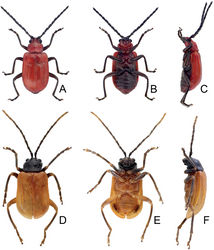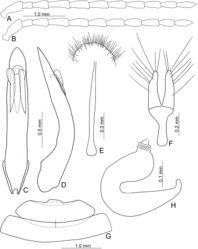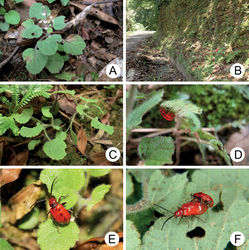Japonitata houjayi
| Notice: | This page is derived from the original publication listed below, whose author(s) should always be credited. Further contributors may edit and improve the content of this page and, consequently, need to be credited as well (see page history). Any assessment of factual correctness requires a careful review of the original article as well as of subsequent contributions.
If you are uncertain whether your planned contribution is correct or not, we suggest that you use the associated discussion page instead of editing the page directly. This page should be cited as follows (rationale):
Citation formats to copy and paste
BibTeX: @article{Lee2022ZooKeys1125, RIS/ Endnote: TY - JOUR Wikipedia/ Citizendium: <ref name="Lee2022ZooKeys1125">{{Citation See also the citation download page at the journal. |
Ordo: Coleoptera
Familia: Chrysomelidae
Genus: Japonitata
Name
Japonitata houjayi Lee, 2022 sp. nov. – Wikispecies link – ZooBank link – Pensoft Profile
Types
Holotype ♂ (TARI). Taipei, Shihtzutoukeng (獅子頭坑), 300 m, 1.V.2010, leg. H.-J. Chen. Paratypes: 1♂, 5♀ (TARI), same data as holotype; 4♂, 1♀ (TARI), same but with “4.V.2010”; 4♂, 3♀ (TARI), same but with “8.V.2010”; 1♂, 1♀ (TARI), same but with “26.V.2010”; 3♂, 4♀ (TARI), same but with “28.V.2010”; 3♂ (TARI), same but with “leg. H. Lee”; 1♂ (TARI), same locality, 25.IV.2012, leg. H.-J. Chen.
Description
Length 5.5–6.6 mm, width 2.7–3.4 mm. General color (Fig. 1A–C) reddish brown; antennae black; legs dark brown. Antennomeres II–XI filiform but stout in males (Fig. 2A), ratios of lengths of antennomeres I–XI 1.0: 0.4: 0.7: 0.9: 0.8: 0.8: 0.8: 0.8: 0.7: 0.7: 0.8; ratios of length to width from antennomeres I–XI 2.5: 1.5: 1.9: 2.7: 2.5: 2.5: 2.5: 2.5: 2.4: 2.4: 3.5; stout antennae in males similar in females (Fig. 2B), ratios of lengths of antennomeres I–XI 1.0: 0.4: 0.6: 0.8: 0.8: 0.7: 0.8: 0.7: 0.7: 0.6: 0.8; ratios of length to width from antennomeres I–XI 2.5: 1.5: 2.0: 2.5: 2.4: 2.3: 2.5: 2.4: 2.6: 2.3: 2.9. Pronotum 1.6–1.7 × wider than long; disc with scarce, fine punctures at sides, reduced medially, with transverse groove near base, medially abbreviated, laterally connected with short longitudinal groove on basal margin; lateral margins slightly rounded, widest behind apices; apical margin slightly concave and basal margin slightly convex. Elytra 1.5 × longer than wide; disc with confused, dense, reduced punctures; with one small tubercle behind scutellum; with one distinct longitudinal ridge from humeral calli, parallel with lateral margin, abbreviated subapically; with one additional ridge also from humeral calli, distinct, directed medially; lateral margins moderately rounded, widest at apical third, apices convergent. Aedeagus (Fig. 2C, D) extremely slender, 7.5 × longer than wide; parallel-sided, slightly narrowed at apical 1/4, strongly narrowed subapically, apex narrowly rounded; moderately curved at basal 1/3 in lateral view; tectum slender, longitudinal, apex recurved; no endophallic sclerites. Apical margin of abdominal ventrite V in males with distinct, narrow median lobe (Fig. 2G), apical margin slightly recurved, with short median internal ridge at middle of basal margin, from basal fourth to base; basal margin normal. Gonocoxae (Fig. 2F) longitudinal and connected basally, with narrow furrow between gonocoxae; each gonocoxa narrowed subapically, apex narrowly rounded, with eight long apical setae; base strongly sclerotized and narrow. Ventrite VIII (Fig. 2E) in females with apex weakly sclerotized, small, apical margin irregular; with dense short apical setae; spiculum extremely elongate. Spermathecal receptaculum (Fig. 2H) swollen, not delimited from pump; pump long and curved, with apical process curved; sclerotized spermathecal duct extremely short, not separated from receptaculum.
Diagnosis
Adults of J. houjayi sp. nov. are similar to those of J. ruficollis Jiang, 1989 from China (Xizang) with reddish brown bodies, but differ in possessing black antennae and dark brown legs (yellow antenna with one or two apical antennomeres black, and reddish brown legs in J. ruficollis).
Host plant
Scutellaria indica L. (Lamiaceae).
Biology
Scutellaria indica is a small herbaceous plant (Fig. 3A) growing on slopes along roads (Fig. 3B). Adults appear only during May, usually resting on the undersides of leaves during daytime (Fig. 3C, D). Adults feed on the leaves (Fig. 3E) and were observed mating (Fig. 3F) occasionally.
Etymology
The new species name is dedicated to Mr. Hou-Jay Chen (陳厚潔), the first team member to find the habitat and collect type specimens.
Distribution
This new species is known only from the type locality.
Original Description
- Lee, C; 2022: The genus Japonitata Strand (Insecta, Coleoptera, Chrysomelidae, Galerucinae) in Taiwan: a redefinition of the genus and descriptions of two new species ZooKeys, 1125: 171-192. doi
Images
|


